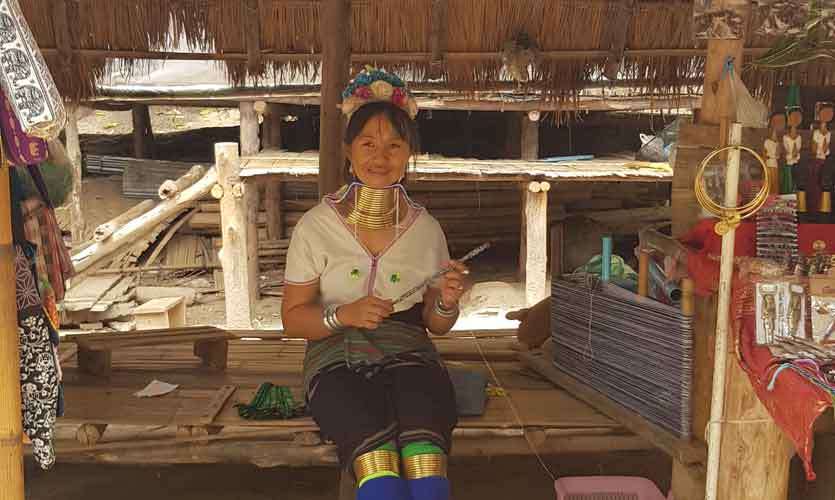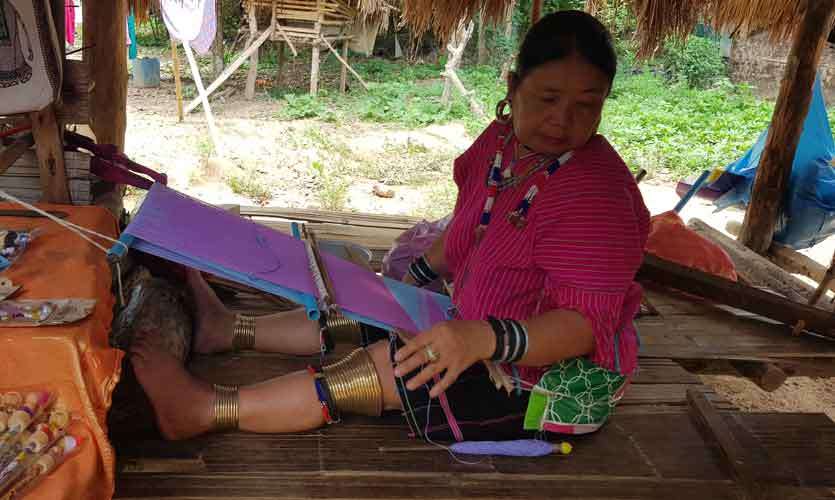
Jul 26 2019.
views 626When asked if I was interested in visiting the Long Neck Karen village in Chiang Mai, Northern Thailand, it was a hard pass from me. While I was always fascinated by the women wearing several brass rings to elongate their necks, I felt like this ‘attraction’ sounded a little controversial. Besides, the ‘village’ gave every impression of being pretty inauthentic and considering that they charged visitors 500 baht per person to visit, it felt like I’d be paying to visit a human zoo, a fact that grossed me out, especially bearing in mind how depraved the idea was. But after being reassured that it wasn’t so, I decided to see for myself.

Who are the Long Neck Karens?
The Karens are a tribal group from Myanmar, many of whom fled persecution in their home country and crossed into Northern Thailand. Since the border was crossed illegally, the Karens are refugees with limited freedom, often relegated to particular areas with bleak employment opportunities. The Karens are recognised world over specifically for their women, whose elongated necks are highlighted by striking brass rings. In Thailand, the men are often engaged in farming, while the women make their living thanks to their incredible craftsmanship in weaving and wood carving.
The story behind the long necks
The Karen women are defined by their long necks and their traditional brass rings. While this practice may shock many, their function is not purely intended for superficial purposes, meant to enhance the looks of the wearer. In fact, the brass rings were worn to protect the women’s necks from tigers. Eventually, it is stated that the village leader came to prefer it, thereby solidifying the practice as part of the Karen culture and tradition.

Typically, once a female child turns 5, she is outfitted with brass rings. Over the course of many years, these rings will be replaced with new ones, while also increasing the number of rings to result in a longer neck. A fact that has perplexed many is how the tribe is able to lengthen a woman's neck simply by increasing the number of rings; a doubt that is easily clarified. The brass rings appear deceptively light until you take them in your hands, only to realise how heavy each ring actually is. Essentially, the Karen women achieve their long necks because the heavy rings smash their shoulders and rib cage downwards. The women with longer necks often have around 25 rings on their necks!

Ethical implications of visiting Karen villages
Wanting to visit Karen villages often results in a moral dilemma: should you ever support what appears, at first glance, to be a human zoo? Do the inhabitants of the village even want you there in the first place? I cannot speak for the authenticity of these villages - afterall, there are many in Northern Thailand - but the one I decided to check out in Chiang Mai seemed to be an exhibition village, as opposed to an authentic village, in my opinion at least. The 500 baht I paid to enter, my guide explained, would go directly to the villagers who would share it among themselves.
The ‘village’ was essentially a marketplace, where a few karen women were selling their colorful wares. A few had numerous rings around their necks. Some, none at all. My guide explained that with time, the women were given a choice to opt out, if they so wished. A few however, decided to hold onto their traditions.
The visit to the Karen village was quite eye opening, exposing me to a lot of the harsh realities faced by the tribe. Since the Karens are not considered to be Thais, they don’t often find employment; most of the Karen men worked in farms or at the nearby elephant sanctuary, I was told. The villagers thus rely primarily on visiting tourists to purchase souvenirs crafted by the women. But more recently, government restrictions have been loosened to allow them to integrate into Thai society - more avenues for employment have been opened and the Karen children are now allowed to attend Thai school, granted the female members of the Karens remove their rings. It’s been a slow, uphill battle for the Karens, but over time, things seem to be getting better for them, especially considering they can also now visit Thai hospitals, and wander beyond the land allocated to them. The women, however, are expected to cover up their rings when they do.

My initial apprehension for visiting a ‘human zoo’ featuring Karen women dissipated when I strolled on the path flanked by stalls featuring colorful woven item and wooden carvings. It felt like I had wandered into a marketplace, which it kind of was. The women managed to dispel my awkwardness and invited me to take photographs with them. Others eagerly showed me their wares and invited me to check out the brass rings. Although they do not speak English, most understand Thai, and you can converse with them if you have a Thai guide. It is a great opportunity to learn about a different culture and understand the reasons they choose to follow traditions. While it is imperative that the Karen heritage is preserved, it is also clear that while the Thai government continues to impose restrictions, many of the Karen women would continue to wear their rings for the sole purpose of attracting tourists and not for the sake of preserving their culture.
Pics by: Rihaab Mowlana
0 Comments